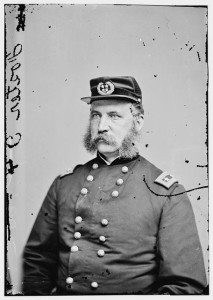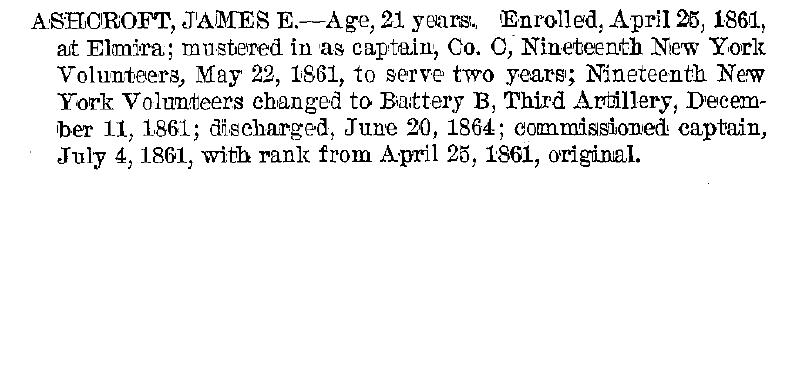More Two-Year Men Come Home; Captain Ashcroft Heads back South
From a Seneca County, New York newspaper in May 1863:
The return of the 19th Regiment.
This Regiment returned to Auburn on Tuesday [May 23] last, having served out its term of enlistment. The Regiment left Newbern, N.C. on the 20th inst., and arrived in New York on Saturday of last week. A very large assemblage of people were at the depot in Auburn to greet these brave and hardy warriors. The Nineteenth was made up mostly of volunteers from Cayuga county, and left for the seat of war under Col. JOHN S. CLARK. It served under PATTERSON in Virginia, in the early part of the campaign, but soon after the first Bull Run battle was changed into an artillery regiment, and sent to North Carolina. The regiment returned some 520 strong, under the command of Col. C.H. STEWART. Capt. ASHCROFT’s company from this place belonged to this Regiment, and about one-quarter of Capt. AMMON’s company were also Seneca falls boys.
Here’s a summary of the last days of the two-year recruits in the 19th Infantry/3rd Artillery[1]
In his parting order General John G. Foster, through his Assistant Adjutant general, urged the soldiers to return:
… The commanding General hopes that, after a brief enjoyment of home, the memory of the brave deeds in which they have participated in this Department, and the memory of their friends left behind, will induce many or all of them, officers and men, to return again to the Department of North Carolina. …
The regiment reached Auburn, New York on May 26th, but apparently the train from New York City made great time:
Plans were laid for a grand reception; but the battalion arrived before it was expected, and there was only time to marshal Capts. White’s, Swift’s, Rhodes’s and Barber’s military companies under Col. J.B. Richardson, Nos. 1, 3 and 4, fire companies and hook and ladder company to greet the returned heroes at the New York Central depot and escort them to the Exchange Hotel on Genesee street, where J.N. Knapp, the Provost Marshal, made them an address, and a collation was provided for them. The city was hung with flags in their honor and the populace, proud of them beyond expression, thronged the streets. Two or three days afterwards, the battalion had a dress parade in front of the Court House and was addressed by Secretary Seward. The men were formally mustered out on June 2d. They were paid off on the 6th.
When I started reading through the newspaper clippings in the Seneca Falls, New York public library from 1860 and early 1861, I realized that Zouave organizations were in the area before the Civil War. James Ashcroft’s name was prominent as a Zouave leader. He formed a non-Zouave company for the 19th Infantry right after the loss of Fort Sumter. While stationed at Fort Hatteras he organized some unionist North Carolinians.
From a Seneca County, New York newspaper in May 1863:
Capt. J.E. Ashcroft
Arrived home from Fort Hatteras, N.C., on Friday evening of last week, having been absent something over two years. Capt. ASHCROFT recruited a company in this village at the commencement of hostilities, which was attached to the old Nineteenth Regiment, afterwards the 3d N.Y. Artillery. He has been in command at Fort Hatteras for nearly a year past, while his old company has been under the charge of Lieut. RANDOLPH. During his command at Fort Hatteras he has raised a company of North Carolinians, which has been placed under Capt. CHARLES GRAVES, who went out with Capt. ASHCROFT as his Orderly Sergeant. Capt. A. has been assigned to the command of Battery B, 3d Artillery, now at Hilton Head, S.C. He will return in the course of a few days.
Captain Ashcroft would spend another year with the 3d Artillery.
\There is evidencethat Charles Graves was promoted to major of the 1st North Carolina.
- [1]Hall, Henry and James Hall. Cayuga in the Field. 1873.Aurora, New York: Talbothays Books. Print. pages 166-67.↩



